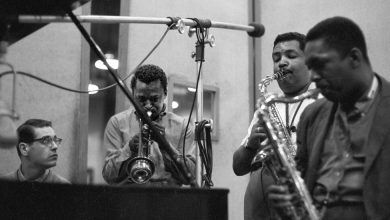Mifune’s Transcendent Films, With and Without Kurosawa

Toshiro Mifune once wrote of his collaboration with the director Akira Kurosawa, “I have never as an actor done anything that I am proud of other than with him.”
OK. Fine. Those were 16 pretty great movies the two of you made together. But you made roughly 170 movies! Never?
We can judge whether Mifune, who died in 1997, was being a little too harsh on himself (and his many other directors) beginning this weekend at Film Forum, where a four-week festival will present 33 of the great Japanese actor’s films, as well as a documentary, “Mifune: The Last Samurai.”
It includes all the movies Mifune and Kurosawa made together — certified masterpieces like “Seven Samurai” and “Rashomon,” as well as less well-known but excellent pictures like “High and Low” and “Red Beard.” The chance to see them on a theater screen shouldn’t be missed.
But a lot has already been said about those films — I don’t have much new to offer on “Seven Samurai” — and it’s the other half of the Film Forum program where you’re more likely to find some surprises.
As a contract player for the Toho studios, Mifune never stopped working — according to “The Last Samurai,” at the peak of his career he appeared in 27 movies in a four-year period. Some of them were filler, no doubt, but the 1950s and ’60s were a great era for Japanese film, and when he wasn’t with Kurosawa, Mifune got to work with other top-flight directors like Hiroshi Inagaki and Masaki Kobayashi.
Here, in the order they were made, are some highlights from the series’s non-Kurosawa productions. Mifune might not have been working with his favorite director, but watching these, it’s clear that he still brought his expressive physicality, his quicksilver emotion and his unparalleled charisma to the set every day.
‘Snow Trail’
Mifune’s first feature, a tense and bittersweet 1947 thriller filmed in the snowy mountains of Hokkaido, feels as if it could be a Kurosawa film. That’s probably because Kurosawa wrote the screenplay for the director, Senkichi Taniguchi. The 27-year-old Mifune had been discovered in a Toho cattle call for actors, and he’s shockingly handsome, with a wild lock of hair hanging down over his face. He also knew how to command the camera from the very start. As the youngest and most ruthless of a group of bank robbers on the lam, he’s a tight bundle of angry, nervous energy — you spend the picture waiting for him to explode. (As an older and more conscience-stricken crook, Takashi Shimura makes the first of many appearances alongside Mifune.)
‘Samurai Saga’
Mifune’s Macbeth in “Throne of Blood” is widely celebrated, but fewer people know that he is also an excellent Cyrano in Inagaki’s 1959 adaptation of “Cyrano de Bergerac.” It’s a kick to see Mifune in a role in which his mastery of language is more important than his looks and just as important as his fighting ability (though swordplay is crucial to the story, of course). French 19th-century romance transfers well to the 17th-century Shogunate; Inagaki stages the famous first-act poetry duel on a Kabuki stage, with Mifune dealing sword blows between verses to an entire company of attackers. And Mifune’s ability to play the alpha male with notes of humor and abashment suits him perfectly when it comes to the ultimate rom-com hero.
Five Movies to Watch This Winter
1. “The Power of the Dog”: Benedict Cumberbatch is earning high praise for his performance in Jane Campion’s new psychodrama. Here’s what it took for the actor to become a seething alpha-male cowboy.
2. “Don’t Look Up” : Meryl Streep plays a self-centered scoundrel in Adam McKay’s apocalyptic satire. She turned to the “Real Housewives” franchise for inspiration.
3. “King Richard”: Aunjanue Ellis, who plays Venus and Serena Williams’s mother in the biopic, shares how she turned the supporting role into a talker.
4. “Tick, Tick … Boom!”: Lin-Manuel Miranda’s directorial debut is an adaptation of a show by Jonathan Larson, creator of “Rent.” This guide can help you unpack its many layers.
5. “The Tragedy of Macbeth”: Several upcoming movies are in black and white, including Joel Coen’s new spin on Shakespeare’s “Macbeth.”
‘The Last Gunfight’
This is one of seven films in the series directed by Kihachi Okamoto, a Toho veteran who was more reliable than spectacular but brought style and a darkly comic sensibility to a variety of genres. Here he gives a sardonic gloss to a colorfully violent 1960 yakuza story, with a good script by writers with notable Japanese new wave credits, Haruhiko Oyabu (“Cruel Gun Story”) and Shin’ichi Sekizawa (“Take Aim at the Police Van”). Mifune stars as a disgraced cop who goes undercover in the middle of a gang war over guns and gravel concessions; in his white suits, he’s the cool center of the psychedelic action, underplaying the stereotypical tough guy and giving a wry spin to his punch lines, like his kiss-off to an overanxious bar hostess: “Easy, a bed won’t run away.”
‘Samurai Rebellion’
The highlight of the series’s non-Kurosawa films, this 1967 revenge drama has the classical feeling — the deliberate pacing, the stark, high-contrast black-and-white images, the harshly delineated emotions — that its director, Kobayashi, brought to his masterpieces in the “Human Condition” trilogy. Mifune plays Isaburo, a midlevel member of an 18th-century feudal clan. When his son is forced to marry an aristocrat’s castoff mistress and then, after they’ve fallen in love and had a child, is ordered to send her back, Isaburo has to choose between paying fealty to his clan lords and upholding his honor and that of his family. You can guess which wins. “Rebellion” is as good a showcase as any of the Kurosawa films for Mifune’s ability to portray unforced but passionate nobility.
‘Japan’s Longest Day’
Okamoto directed this documentary-style 1967 drama about then-recent Japanese history, perhaps with some inspiration from “Seven Days in May,” which had come out a few years before. It counts down the 24 hours before Emperor Hirohito’s August 1945 radio broadcast announcing Japan’s surrender in World War II, during which an attempted coup by young army and air force officers comes uncomfortably close to success. Mifune is part of the requisite all-star cast, along with other Japanese idols like Shimura and Chishu Ryu. Mifune lends considerable dignity and quiet anguish to the role of General Anami, the war minister, who must try to negotiate a peace he can live with during marathon cabinet meetings while dealing with the agitated (and wildly overacting) hotheads who keep demanding that Japan fight on.
‘Red Lion’
Mifune was 49 and running his own large production company by the time he made this rambunctious, satirical, eventually tragic period piece with Okamoto in 1969. He was already starring in big international productions that made little use of his talents, and he was about to start in on the television work that would occupy much of the last two decades of his career. But he could still bring tremendous comic energy to the part of Gonzo, an excitable peasant soldier who gets to return to his home village and pretend to be an officer in the army fighting to restore the Japanese monarchy. His exuberance carries the picture as Gonzo pulls together a coalition of prostitutes, students and children to battle the corrupt minions of the shogun.
“Mifune” runs through March 30. For more information, go to filmforum.org.





